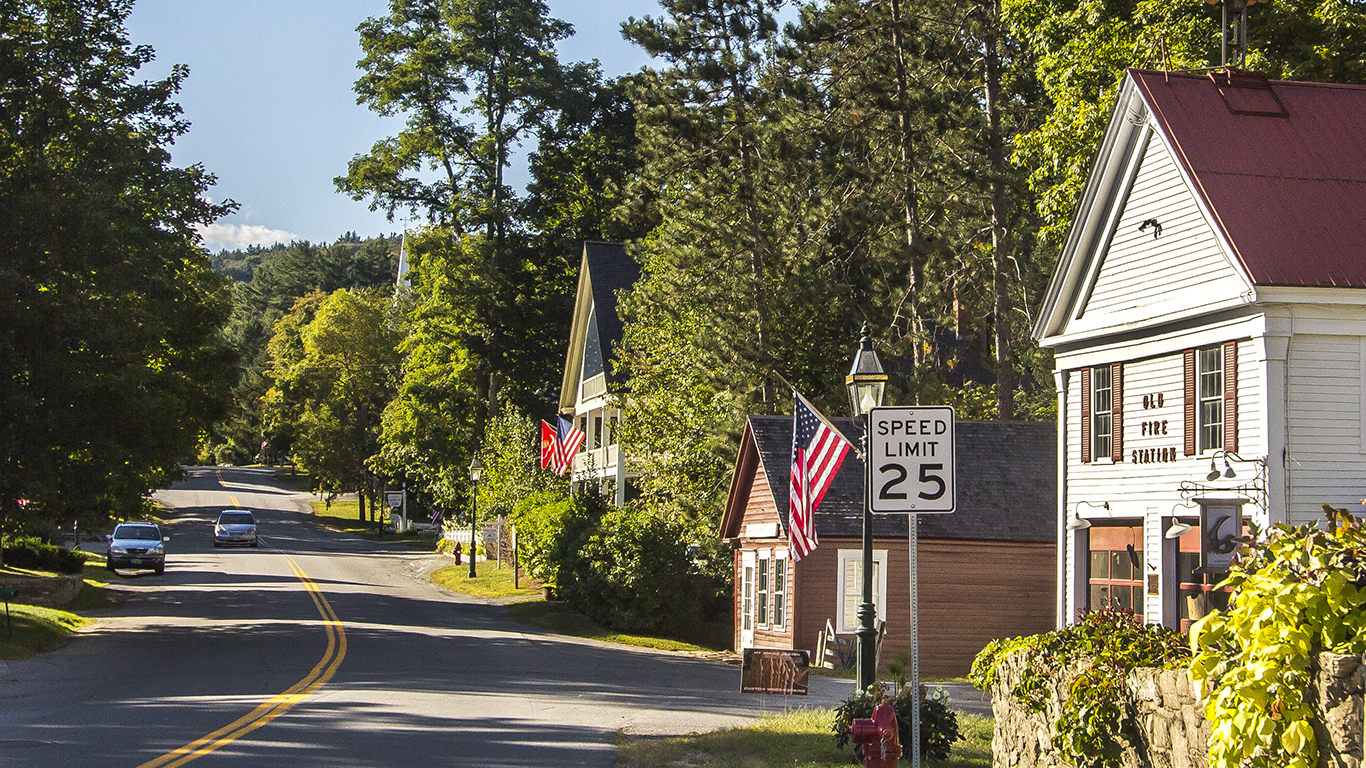Special Report
12 Worst States for Lyme Disease

Published:
Last Updated:

Though it is not one of the most feared infections in the United States, Lyme disease is a debilitating, sometimes fatal infection passed to humans by infected blacklegged ticks. There were more than 29,500 confirmed cases of Lyme disease in the United States in 2017 — or 9.1 per 100,000 people. Humans contract the disease when a blacklegged tick infected with the bacterium Borrelia burgdorferi bites them and stays attached for 36 to 48 hours.
24/7 Tempo reviewed CDC data on confirmed cases of the disease to determine the worst states in the country for Lyme disease. The climate in Northeastern states tends to be more hospitable to disease-carrying ticks and the animals that carry them, and as a result, Lyme disease incidence rates tend to be higher in the Northeast and mid-Atlantic.
Lyme disease has a wide range of symptoms. Shortly after the tick bites, a rash can develop at the site, though not in all cases. Other early signs include flu-like symptoms such as fevers, headaches, and joint pain. The disease can be treated with antibiotics. If left untreated, later symptoms can include neck stiffness, inflammation of the brain and spinal cord, pain and numbness in the extremities, and even short-term memory loss.
Americans who are physically active outdoors are at increased risk of contracting Lyme disease — and some of the states on this list are home to cities where people get the most exercise.
To determine the worst states for Lyme disease, 24/7 Wall St. reviewed Lyme disease data from the Centers for Disease Control and Prevention. The data included the incidence of Lyme disease in every state in 2017, the most recent year with available data and the total number of confirmed cases by state. The percentage of adults who are physically active came from County Health Rankings & Roadmaps, a Robert Wood Johnson Foundation and the University of Wisconsin Population Health Institute joint program. Uninsured rates are from the U.S. Census Bureau’s American Community Survey.
Click here to read about the 12 worst states for Lyme disease.

12. Maryland
> Incidence of Lyme disease: 20 per 100,000 residents
> Confirmed cases: 1,194 (8th highest)
> Uninsured rate: 6.1% (18th lowest)
> Pct. adults physically active: 79.0% (20th highest)
Maryland’s location in the South Atlantic region is a hot spot for disease carrying ticks. There were 1,194 confirmed cases of Lyme disease in Maryland in 2017, more than in all but seven other states. The state’s Lyme disease incidence rate of 20 incidents per 100,000 is the 12th highest among states and more than double the 9.1 per 100,000 national rate. Another 697 probable but unconfirmed cases of Lyme in the state in 2017 were not factored into the rate.
[in-text-ad]

11. Minnesota
> Incidence of Lyme disease: 25 per 100,000 residents
> Confirmed cases: 1,408 (6th highest)
> Uninsured rate: 4.4% (3rd lowest)
> Pct. adults physically active: 81.5% (7th highest)
More than 80% of adults in Minnesota report getting some physical activity in their leisure time, one of the higher rates in the nation. As the Land of 10,000 Lakes, Minnesota has lots of space for outdoor activities in rural areas. People who spend their leisure time outdoors in areas with ticks like Minnesota are at greater risk of contracting Lyme disease. There were 1,408 confirmed cases of Lyme in Minnesota in 2017, or 25 for every 100,000 people. The incidence rate of Lyme in Minnesota does not include the more than 900 likely but unconfirmed cases.

10. West Virginia
> Incidence of Lyme disease: 28 per 100,000 residents
> Confirmed cases: 503 (13th highest)
> Uninsured rate: 6.1% (18th lowest)
> Pct. adults physically active: 72.2% (6th lowest)
More than half of West Virginia’s residents live in rural areas, where Lyme disease-carrying ticks are likely to be found. The number of confirmed Lyme disease cases in West Virginia has risen significantly in the last few years, increasing from 112 in 2014, to 243 in 2015, to 297 in 2016. In 2017, there were over 500 confirmed cases in the state, or 28 for every 100,000 people.

9. Wisconsin
> Incidence of Lyme disease: 31 per 100,000 residents
> Confirmed cases: 1,794 (4th highest)
> Uninsured rate: 5.4% (10th lowest)
> Pct. adults physically active: 80.5% (12th highest)
Along with Minnesota, Wisconsin is one of two Midwestern states to rank on this list. The incidence of Lyme disease per 100,000 people in Wisconsin increased from 26 in 2016 to 31 in 2017. Wisconsin residents who are infected with Lyme are more likely than most Americans to seek medical treatment. Just 5.4% of Wisconsin residents are without health insurance compared to the 8.7% national uninsured rate.
[in-text-ad-2]

8. Connecticut
> Incidence of Lyme disease: 39 per 100,000 residents
> Confirmed cases: 1,381 (7th highest)
> Uninsured rate: 5.5% (12th lowest)
> Pct. adults physically active: 80.7% (11th highest)
Lyme disease derives its name from Lyme, Connecticut — a town where, in 1975, a number of residents reported unusual arthritic symptoms. The bacteria that causes the disease was identified in 1982, and five years later, Lyme was designated a disease of great public importance. Lyme disease remains a major concern in the state, infecting about 39 people in 100,000 in 2017, nearly four times the nationwide incidence rate.

7. New Jersey
> Incidence of Lyme disease: 40 per 100,000 residents
> Confirmed cases: 3,629 (2nd highest)
> Uninsured rate: 7.7% (24th lowest)
> Pct. adults physically active: 76.4% (17th lowest)
New Jersey’s location in the mid-Atlantic region is a hot spot for disease carrying ticks. There were 3,629 confirmed cases of Lyme disease in the Garden State in 2017, the second most in the country after only Pennsylvania. The state’s Lyme disease incidence rate of 40 incidents per 100,000 is seventh highest among states and more than quadruple the 9.1 per 100,000 national rate. Another 1,463 probable but unconfirmed cases of Lyme in the state in 2017 were not factored into the rate.
[in-text-ad]

6. Delaware
> Incidence of Lyme disease: 44 per 100,000 residents
> Confirmed cases: 421 (14th highest)
> Uninsured rate: 5.4% (10th lowest)
> Pct. adults physically active: 74.6% (9th lowest)
Delaware’s incidence of confirmed Lyme disease cases increased slightly in 2017, from 41 cases per 100,000 residents in 2016 to 44 cases per 100,000 residents. The increase may have been the result of Delaware’s campaign to raise public awareness of the disease. If previously some people who contracted the disease were unaware and never diagnosed, many more are now better informed of the symptoms and more are likely correctly diagnosed.

5. Rhode Island
> Incidence of Lyme disease: 56 per 100,000 residents
> Confirmed cases: 595 (12th highest)
> Uninsured rate: 4.6% (5th lowest)
> Pct. adults physically active: 76.6% (19th lowest)
With 56 confirmed cases for every 100,000 people in 2017, Lyme disease is more common in Rhode Island than in neighboring Connecticut and Massachusetts. Partially because Lyme disease is such a concern in the state and the region, Rhode Island is home to a number of facilities that specialize in diagnosing and treating the disease, including Lyme Center of New England and the Lifespan Lyme Disease Center at the Miriam Hospital in Providence.

4. New Hampshire
> Incidence of Lyme disease: 71 per 100,000 residents
> Confirmed cases: 956 (10th highest)
> Uninsured rate: 5.8% (14th lowest)
> Pct. adults physically active: 80.0% (17th highest)
There were 956 confirmed cases of Lyme disease in New Hampshire in 2017, up considerably from the 691 in 2016 and more than double the 436 cases in 2015. All told, there were 71 incidents for every 100,000 people in the state in 2017, the third highest rate in the New England region and fourth highest nationwide.
[in-text-ad-2]

3. Pennsylvania
> Incidence of Lyme disease: 72 per 100,000 residents
> Confirmed cases: 9,250 (the highest)
> Uninsured rate: 5.5% (12th lowest)
> Pct. adults physically active: 77.6% (24th lowest)
Pennsylvania had 9,250 confirmed cases of Lyme disease in 2017, by far the most of any state and higher than the next three highest states combined. Pennsylvania accounts for more than one-third of total confirmed Lyme disease cases in the United States. Due to the state’s relatively large population, however, it ranks behind two other states in incidence rate of the disease, at 72 cases per 100,000 residents in 2017.

2. Vermont
> Incidence of Lyme disease: 104 per 100,000 residents
> Confirmed cases: 646 (11th highest)
> Uninsured rate: 4.6% (5th lowest)
> Pct. adults physically active: 81.4% (8th highest)
Vermont has a large rural population and is known for its outdoor activities, such as hiking, camping, and backpacking. This, and the fact that the state is in the midst of the blacklegged ticks’ habitat, means state residents are among the most likely in the country to contract Lyme disease. There were 646 confirmed cases in the state in 2017, or 104 per 100,000 people.
[in-text-ad]

1. Maine
> Incidence of Lyme disease: 107 per 100,000 residents
> Confirmed cases: 1,424 (5th highest)
> Uninsured rate: 8.1% (25th highest)
> Pct. adults physically active: 79.8% (18th highest)
Maine’s incidence of confirmed Lyme disease cases of 107 per 100,000 residents in 2017 was the highest of any state. It was also more than 10 times higher than the national incidence rate of 9.1 cases per 100,000 residents. A primarily rural state, many in Maine are likely to be close to grassy and wooded areas where disease-carrying blacklegged ticks tend to live.
Start by taking a quick retirement quiz from SmartAsset that will match you with up to 3 financial advisors that serve your area and beyond in 5 minutes, or less.
Each advisor has been vetted by SmartAsset and is held to a fiduciary standard to act in your best interests.
Here’s how it works:
1. Answer SmartAsset advisor match quiz
2. Review your pre-screened matches at your leisure. Check out the advisors’ profiles.
3. Speak with advisors at no cost to you. Have an introductory call on the phone or introduction in person and choose whom to work with in the future
Thank you for reading! Have some feedback for us?
Contact the 24/7 Wall St. editorial team.